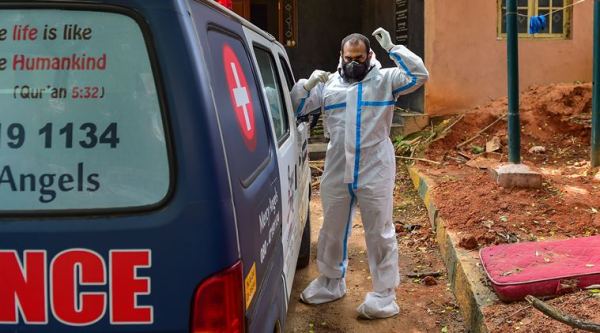 As on July 21, the Covid-19 deaths per million population in Bengaluru was 74.8 as compared to 23.8 for the state.
As on July 21, the Covid-19 deaths per million population in Bengaluru was 74.8 as compared to 23.8 for the state.
After checking on the condition of Covid-19 patients in an ICU at KIMS Hospital in Dharwad district, pulmonologist Dr Raghavendra, who is sitting in Columbia Asia Hospital in Bengaluru, tells doctors in Dharwad about a new study on Covid-19 treatment published in the International Journal of Infectious Diseases.
The interaction is happening as part of the tele-ICU facility started by the state health department in April for effective treatment of critical Covid-19 patients in hospitals in the districts. This system has played a key role in reducing deaths in these hospitals and in keeping doctors in the districts abreast with latest developments in Covid-19 treatment.
Initially started in 28 district hospitals, the tele-ICU facility has now expanded to 68 hospitals with medical experts from top private hospitals in Bengaluru checking on ICU patients daily and discussing treatment for every critical patient. With the system playing a key role in keeping case fatality rates in some districts as low as 0.54 per cent, the health department has now moved to use it in Bengaluru.
“If we look at the statistics across districts, we have provided tele-ICU facilities from our hospital to 15 districts and the death rate is 1.33 per cent. In Bengaluru, the death rate was as high as five per cent at one point. By providing tele-ICU and effective bed coordination, the death rate can be reduced,” said Dr Pradeep Rangappa, an intensive care specialist at Columbia Asia Hospital, who heads a team of doctors involved in daily tele-rounds of ICUs.
“We are able to provide standardised treatment for patients across hospitals and districts. And we also keep doctors in the districts abreast with the latest developments in the treatment of Covid-19 around the world,” Dr Rangappa said.
Treatment protocols have been drawn up with doctors from the state-run Rajiv Gandhi Institute of Chest Disease and are constantly updated with the latest research findings, he said. The 30 districts in the state have been divided into smaller units and responsibility has been distributed across three private hospitals – Manipal Hospital, Columbia Asia and Narayana Health.
“Columbia Asia and Manipal Hospital have been on board since the Critical Care Support programme began three months ago and NH has come on board now and will work with Bengaluru hospitals,” said Dr Vasanth Kumar, assistant director with the state government’s e-hospital initiative.
According to the Critical Care Support plan devised by the health department, the external experts will be available every day for an eight-hour shift that includes two tele-rounds of ICUs in the district hospitals for about two hours each. The experts will also be available on call to resolve issues or address emergencies.
As on July 21, the Covid-19 deaths per million population in Bengaluru was 74.8 as compared to 23.8 for the state. The case fatality rate was on par with that of the state at 2.1 per cent. The government-run Victoria Hospital in Bengaluru has recorded 97 per cent deaths among patients who were Covid-19 positive and on ventilators in the ICU.
Medical Education Minister Dr K Sudhakar said the tele-ICU model used for district hospitals “has been adopted by some states after studying the Karnataka model”. During a recent inspection of Bowring Hospital in Bengaluru, the minister insisted on the hospital signing up for tele-ICU services after learning there was a high incidence of deaths.
“The battle against Covid-19 is not a battle of doctors in private sector alone or… government sector alone. In Karnataka, private doctors and public sector doctors are collaborating to effectively treat patients,” said Dr Rangappa.